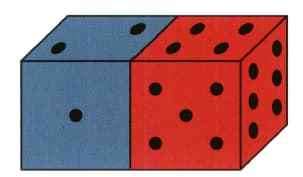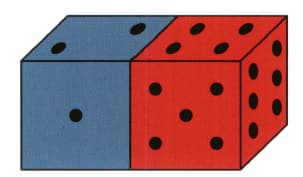Two ordinary fair dice are rolled and the two faces on which they come to rest are hidden by holding the dice together, as shown, and lifted off the table.

The sum of the numbers on the visible faces of the dice is denoted by
Find the number of possible values of and find the most likely value of


Important Questions on Permutations and Combinations
Two ordinary fair dice are rolled and the two faces on which they come to rest are hidden by holding the dice together, as shown, and lifted off the table.

The sum of the numbers on the visible faces of the dice is denoted by
Calculate the probability that
Three identical cans of cola, identical cans of green tea and identical cans of orange juice are arranged in a row. Calculate the number of arrangements if
the first and last cans in the row are the same type of drink,
Three identical cans of cola, identical cans of green tea and identical cans of orange juice are arranged in a row. Calculate the number of arrangements if
the cans of cola are all next to each other and the cans of green tea are not next to each other.
